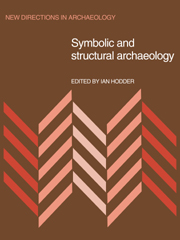Book contents
- Frontmatter
- Contents
- List of contributors
- Preface
- Part one The development of theory
- Part two The search for models
- Part three Application: the analysis of archaeological materials
- 11 Boundedness in art and society
- 12 Ideology, symbolic power and ritual communication: a reinterpretation of Neolithic mortuary practices
- 13 Ideology, change and the European Early Bronze Age
- 14 Sequences of structural change in the Dutch Neolithic
- Part four Commentary
- Index
12 - Ideology, symbolic power and ritual communication: a reinterpretation of Neolithic mortuary practices
Published online by Cambridge University Press: 27 February 2010
- Frontmatter
- Contents
- List of contributors
- Preface
- Part one The development of theory
- Part two The search for models
- Part three Application: the analysis of archaeological materials
- 11 Boundedness in art and society
- 12 Ideology, symbolic power and ritual communication: a reinterpretation of Neolithic mortuary practices
- 13 Ideology, change and the European Early Bronze Age
- 14 Sequences of structural change in the Dutch Neolithic
- Part four Commentary
- Index
Summary
The first part of this chapter attempts to arrive at an adequate notion and definition of ideology. An alternative to the viewpoint of Althusser concerning the nature of ideology is discussed, and the close relationship between ideological and symbolic form emphasised. Material symbols, especially those involved in ritual such as burial of the dead, may play an active part in the misrepresentation or concealment of real social relations. The treatment and arrangement of the human skeleton at burial can be used to provide a number of particularly powerful symbolic contrasts. An analysis of the skeletal remains in Neolithic barrows from Wessex and the Cotswolds in southern England and from southern Sweden is carried out. It is suggested that the preservation biasses can be accounted for in the analyses, and it is shown that non-random selection of bones between and within the tombs can be identified, and that contrasts occur between articulated and disarticulated skeletons, adult and immature remains, left and right parts of the body, male and female. Possible interpretations of the patterning are discussed in relation to ethnographic data, and it is suggested that the burial symbolism was involved ideologically within the context of symmetric kin organisation and asymmetric social control by lineage heads.
Introduction
This paper is an attempt to reinterpret Neolithic mortuary practices in two distinct areas of north western Europe: Wessex and the Cotswolds in southern England and Scania in southern Sweden. The main focus of our attention is the human osteological deposits within earthen and chambered long barrows.
- Type
- Chapter
- Information
- Symbolic and Structural Archaeology , pp. 129 - 154Publisher: Cambridge University PressPrint publication year: 1982
- 122
- Cited by



